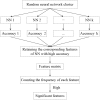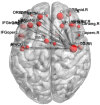Analysis of Alzheimer's Disease Based on the Random Neural Network Cluster in fMRI
- PMID: 30245623
- PMCID: PMC6137384
- DOI: 10.3389/fninf.2018.00060
Analysis of Alzheimer's Disease Based on the Random Neural Network Cluster in fMRI
Abstract
As Alzheimer's disease (AD) is featured with degeneration and irreversibility, the diagnosis of AD at early stage is important. In recent years, some researchers have tried to apply neural network (NN) to classify AD patients from healthy controls (HC) based on functional MRI (fMRI) data. But most study focus on a single NN and the classification accuracy was not high. Therefore, this paper used the random neural network cluster which was composed of multiple NNs to improve classification performance. Sixty one subjects (25 AD and 36 HC) were acquired from the Alzheimer's Disease Neuroimaging Initiative (ADNI) dataset. This method not only could be used in the classification, but also could be used for feature selection. Firstly, we chose Elman NN from five types of NNs as the optimal base classifier of random neural network cluster based on the results of feature selection, and the accuracies of the random Elman neural network cluster could reach to 92.31% which was the highest and stable. Then we used the random Elman neural network cluster to select significant features and these features could be used to find out the abnormal regions. Finally, we found out 23 abnormal regions such as the precentral gyrus, the frontal gyrus and supplementary motor area. These results fully show that the random neural network cluster is worthwhile and meaningful for the diagnosis of AD.
Keywords: Alzheimer’s disease; classification; fMRI; functional connectivity; random neural network cluster.
Figures







Similar articles
-
Classification and Graphical Analysis of Alzheimer's Disease and Its Prodromal Stage Using Multimodal Features From Structural, Diffusion, and Functional Neuroimaging Data and the APOE Genotype.Front Aging Neurosci. 2020 Jul 30;12:238. doi: 10.3389/fnagi.2020.00238. eCollection 2020. Front Aging Neurosci. 2020. PMID: 32848713 Free PMC article.
-
The Diagnosis of Autism Spectrum Disorder Based on the Random Neural Network Cluster.Front Hum Neurosci. 2018 Jun 26;12:257. doi: 10.3389/fnhum.2018.00257. eCollection 2018. Front Hum Neurosci. 2018. PMID: 29997489 Free PMC article.
-
Random support vector machine cluster analysis of resting-state fMRI in Alzheimer's disease.PLoS One. 2018 Mar 23;13(3):e0194479. doi: 10.1371/journal.pone.0194479. eCollection 2018. PLoS One. 2018. PMID: 29570705 Free PMC article. Clinical Trial.
-
Analysis of structural brain MRI and multi-parameter classification for Alzheimer's disease.Biomed Tech (Berl). 2018 Jul 26;63(4):427-437. doi: 10.1515/bmt-2016-0239. Biomed Tech (Berl). 2018. PMID: 28622141
-
A Deep Learning Approach for Automated Diagnosis and Multi-Class Classification of Alzheimer's Disease Stages Using Resting-State fMRI and Residual Neural Networks.J Med Syst. 2019 Dec 18;44(2):37. doi: 10.1007/s10916-019-1475-2. J Med Syst. 2019. PMID: 31853655
Cited by
-
Deep Learning-Based Ensembling Technique to Classify Alzheimer's Disease Stages Using Functional MRI.J Healthc Eng. 2023 Nov 3;2023:6961346. doi: 10.1155/2023/6961346. eCollection 2023. J Healthc Eng. 2023. PMID: 37953911 Free PMC article.
-
Detecting genetic associations with brain imaging phenotypes in Alzheimer's disease via a novel structured SCCA approach.Med Image Anal. 2020 Apr;61:101656. doi: 10.1016/j.media.2020.101656. Epub 2020 Jan 23. Med Image Anal. 2020. PMID: 32062154 Free PMC article.
-
Classification and Graphical Analysis of Alzheimer's Disease and Its Prodromal Stage Using Multimodal Features From Structural, Diffusion, and Functional Neuroimaging Data and the APOE Genotype.Front Aging Neurosci. 2020 Jul 30;12:238. doi: 10.3389/fnagi.2020.00238. eCollection 2020. Front Aging Neurosci. 2020. PMID: 32848713 Free PMC article.
-
A Novel Key Features Screening Method Based on Extreme Learning Machine for Alzheimer's Disease Study.Front Aging Neurosci. 2022 May 25;14:888575. doi: 10.3389/fnagi.2022.888575. eCollection 2022. Front Aging Neurosci. 2022. PMID: 35693342 Free PMC article.
-
Hippocampal Subregion and Gene Detection in Alzheimer's Disease Based on Genetic Clustering Random Forest.Genes (Basel). 2021 May 1;12(5):683. doi: 10.3390/genes12050683. Genes (Basel). 2021. PMID: 34062866 Free PMC article.
References
-
- Alam S., Kwon G. R. (2017). Alzheimer disease classification using KPCA, LDA, and multi-kernel learning SVM. Int. J. Imaging Syst. Technol. 27 133–143. 10.1002/ima.22217 - DOI
-
- Azar A. T., Hassanien A. E. (2015). Dimensionality reduction of medical big data using neural-fuzzy classifier. Soft Comput. 19 1115–1127. 10.1007/s00500-014-1327-4 - DOI
LinkOut - more resources
Full Text Sources
Other Literature Sources
Research Materials

